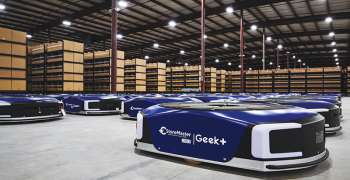Plastic pallets 101
“Plastics!” If you’re old enough to remember “The Graduate,” plastics was the one-word piece of career advice offered to Dustin Hoffman after college graduation.
Things may not be quite that dramatic in the pallet industry – wood is still by far the material of choice for pallets by most shippers. The last time Modern surveyed its readers, fewer than 9% were using plastic pallets. But the interest in plastic pallets is clearly growing.
In part, that interest is the result of regulatory concerns in the food and beverage industry as well as a highly-publicized product recall by Johnson & Johnson that was blamed on a chemical treatment used in wooden pallets produced overseas. “Companies in the food industry, especially the agricultural industry, are converting to plastic because of FDA regulations,” says Abby Verbeten, pallet marketing manager for Orbis ([url=http://www.orbiscorporation.com]http://www.orbiscorporation.com[/url]). “Plastic is non-porous, so nothing will seep in to contaminate the pallets, and they’re washable.” When hygiene counts, plastic has real advantages over wood.
And in part, renewed interest is being driven by the plastic pallet pooling system developed by iGPS ([url=http://www.igps.net]http://www.igps.net[/url]). The pool allows end users who can control their assets to rent plastic pallets on a per trip basis that’s comparable to wooden pallets. “We are seeing some organic growth by our existing customers in the soft drink and beverage industry,” says Bill Mashy, general manager, material handling business group for Rehrig Pacific ([url=http://www.rehrigpacific.com]http://www.rehrigpacific.com[/url]). “But the companies that are converting from wood to pallet are participating in a pool.”
There are other benefits to plastic pallets besides hygenics, say Mashy and Verbeten.
Ergonomics: As a general rule a plastic pallet weighs less than a comparable wooden pallet designed to handle the same load. That can result in fewer lifting-related back and shoulder injuries.
Safety: Plastic pallets are not only washable, there are no nails, splinters or wooden shavings that can damage product or injure an employee.
Long life: Both Verbeten and Mashy say they have customers using plastic pallets that have been in the field for 15 years. While some wooden pallets have also delivered years of service, they will have been repaired multiple times over that period. The expense of repairs has to be factored into the overall cost of using wood pallets.
Sustainable: Like a wood pallet, plastic pallets can be recycled at the end of their useful life. Are they green? Wood pallet manufacturers will argue that plastic pallets are a byproduct of petroleum and treated with flame-retardant chemicals, making their green bonafides suspect. Plastic pallet manufacturers will argue that wood pallets are the result of cutting down valuable hardwood forests, are also sometimes treated with noxious chemicals and can transport pests and bacteria. We’ll let end users sort through those arguments with their in-house sustainability experts. Depending on your corporate priorities, both wood and plastic have pluses and minuses when it comes to sustainability.
Still, there’s a reason that plastic remains a niche option for pallet users: A plastic pallet is significantly more expensive than a new or used wood pallet. “If you can’t control your assets return that plastic pallet into the supply chain, you can’t justify the difference in price between a wooden pallet and a plastic pallet,” says Verbeten. “And, if your pallets don’t turn very often, you may not see a return on investment.” Likewise, if you need a rackable pallet, plastic pallets can be reinforced with steel, but they’re costly if they’re not part of a pallet pool.
Where, then, do plastic pallets fit? Here are some factors to consider:
Closed loop supply chain: Whether you own your plastic pallets or participate in a plastic pallet pool, you have to control the asset to make it work. It’s one thing to lose a $10 wooden pallet; it’s another thing entirely to lose a $35 – or more – plastic pallet. Beverage manufacturers, for instance, will use plastic pallets for direct to store delivery, where they can pick up an empty pallet when they drop off a pallet of new stock.
Inside the four walls: While most pallets are used to ship product across the supply chain, pallets are also used for strictly internal processes. Examples include slave pallets that are used for storage or captive pallets used for storing work-in-process between manufacturing processes. In those situations, a plastic pallet can deliver a longer life than wood. Likewise, a number of retailers prefer plastic pallets to wood for their in-store floor displays.
Automated systems: Since plastic pallets are highly-engineered and manufactured in a mold, they are more consistent than even new wood pallets. That makes them ideal for automated storage and conveyor systems. Since there are no deck boards to break or stringers to collapse, they are less likely to fail during use and stop the line.
Whether those benefits will justify the added expense of a plastic pallet will be determined by an individual users processes. “Each customer’s economics are different,” says Rehrig Pacific’s Mashy. “But what it usually comes down to is how many times can you turn the pallet during the year. If you’re turning your pallet one or two times a year, plastic will have a hard time competing. If you’re turning that pallet 4, 5 or 6 times a year and you can control you’re supply chain, it gets more interesting.”
Want to learn more about pallets? Join pallet experts as they put context behind the findings of Modern’s 2010 Pallet Usage and Trending Study Webcast on October 28, 2010 at 2 pm ET.

Article Topics
Blogs News & Resources
Vehicle-mounted computers: Beyond rugged New packaging idea for the cold chain Learn from lift truck service history Two voices of reason on pallet materials 60 Seconds with Bob Trebilcock, outgoing executive editor, Modern Materials Handling The reBound Podcast: How Pitney-Bowes is innovating with autonomous vehicles. Packaging Corner: Be open to change More BlogsLatest in Materials Handling
Automate & Accelerate: Replacing Pick-to-Light with the Next Generation of Automation 6 Ways to Re-evalute Fulfillment This Year MHEFI awards record-breaking $231,700 in scholarships to 61 students ALAN opens nominations for 2024 Humanitarian Logistics Awards Kenco to install an AutoStore system at its Jeffersonville, Ind., DC Schneider Electric rolling out WMS and TMS solutions from Manhattan Associates at scale Leaders Q & A with Bryan Ferguson: Resurgence of RFID technology More Materials HandlingAbout the Author
Subscribe to Materials Handling Magazine

Find out what the world's most innovative companies are doing to improve productivity in their plants and distribution centers.
Start your FREE subscription today.
May 2024 Modern Materials Handling

Latest Resources










